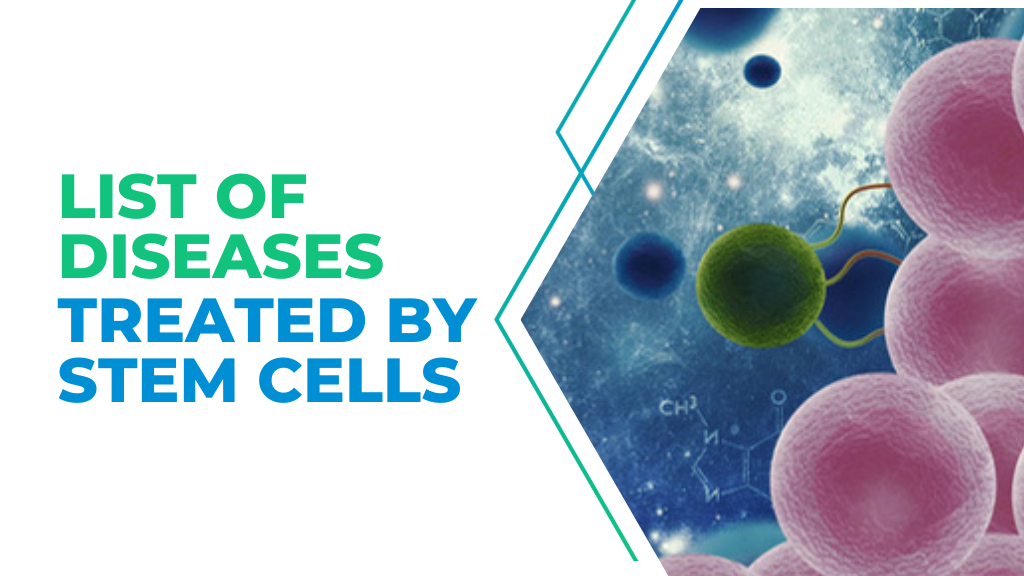Medical science has always aimed to go beyond managing symptoms and instead find ways to heal the body from within. Stem cell therapy is one of the most promising steps in that direction. Unlike conventional treatments that only control disease progression, stem cells work by regenerating or repairing the body’s own tissues. These unique cells, often described as the body’s master cells, have the ability to transform into specialized cells such as neurons, heart muscle, or blood cells. Because of this extraordinary capability, doctors are now treating conditions that once seemed incurable. By exploring the list of diseases treated by stem cells, we can better understand how this therapy is reshaping modern medicine and offering new hope to patients worldwide.
The Science Behind Stem Cells
Stem cells are unlike any other cells in the human body. They are undifferentiated, meaning they have not yet developed into a specific type of cell. Their two key characteristics self-renewal and differentiation make them uniquely powerful. Self-renewal allows them to produce identical copies of themselves, while differentiation enables them to become specialized cells with distinct functions.
There are different types of stem cells, each with its own role in therapy. Embryonic stem cells are highly versatile but raise ethical concerns. Adult stem cells, found in bone marrow and fat tissue, are commonly used in transplants. Umbilical cord blood stem cells are another important source, often collected at birth and stored for future use. More recently, scientists have developed induced pluripotent stem cells, which are adult cells reprogrammed to behave like embryonic stem cells. This breakthrough reduces ethical issues and expands treatment options.
Cancers and Blood Disorders
One of the earliest and most successful uses of stem cell therapy is in the treatment of cancers, particularly those affecting the blood and bone marrow. Leukemia, lymphoma, and multiple myeloma often destroy healthy blood-forming cells, leaving patients without a functioning immune system. Through a stem cell transplant, diseased marrow can be replaced with healthy cells that regenerate a new, working immune system.
For example, in acute lymphoblastic leukemia, chemotherapy alone may not be enough to prevent relapse. In such cases, stem cell transplantation offers a chance for long-term remission. Similarly, patients with Hodgkin’s lymphoma or non-Hodgkin’s lymphoma may benefit from transplantation when standard treatments fail.
Beyond cancers, stem cells are also crucial in treating non-malignant blood disorders. Patients with sickle cell disease or thalassemia, who often suffer from chronic anemia and organ damage, have experienced improved health and even cures through stem cell transplants. In aplastic anemia, where the bone marrow fails to produce enough blood cells, transplants can restore normal cell production and save lives.
Autoimmune Diseases and Immune Regulation
Autoimmune diseases occur when the immune system, which is supposed to protect the body, mistakenly attacks healthy tissues. Conventional treatments often involve lifelong use of immunosuppressants, which reduce symptoms but increase the risk of infections. Stem cell therapy takes a different approach by essentially “rebooting” the immune system.
In multiple sclerosis (MS), for instance, immune cells attack the protective covering of nerves, leading to muscle weakness and loss of coordination. Stem cell transplants can halt disease progression by replacing faulty immune cells with new, properly functioning ones. Clinical trials have shown that many MS patients treated with stem cells experience fewer relapses and improved mobility.
Systemic lupus erythematosus (SLE) is another autoimmune disorder where stem cell therapy shows promise. In severe cases where traditional therapies fail, transplants may reduce inflammation and restore immune balance. Similarly, Crohn’s disease, a chronic digestive disorder, has been studied for stem cell therapy, with some patients achieving long-term remission.
Neurological Disorders and Brain Repair
The nervous system poses one of the greatest challenges in medicine because neurons do not regenerate easily. This makes neurological diseases devastating, often leading to permanent disability. Stem cell research in this area is rapidly expanding, with encouraging results.
In Parkinson’s disease, the loss of dopamine-producing neurons leads to tremors, stiffness, and difficulty in movement. Experimental stem cell treatments are aiming to replace these lost neurons, restoring normal brain function. Alzheimer’s disease, which causes memory loss and cognitive decline, is another area of interest. Although still in the early stages, stem cell therapies could help regenerate neurons and slow the progression of dementia.
Stroke patients may also benefit from stem cell therapy. After a stroke, parts of the brain suffer from reduced blood flow and cell death. Stem cells may help repair damaged tissue and promote recovery of motor and speech functions. Similarly, spinal cord injury patients are part of clinical trials testing the ability of stem cells to restore mobility by regenerating nerve connections.
Cardiovascular and Vascular Diseases
Heart disease remains the number one cause of death globally, and treatment options have traditionally been limited to lifestyle changes, medications, or surgery. Stem cells are now being studied as a way to regenerate damaged heart muscle after a heart attack. By injecting stem cells into affected areas, doctors hope to strengthen cardiac function and reduce the risk of heart failure.
Studies have also examined the role of stem cells in treating peripheral artery disease, where poor circulation leads to pain and tissue damage in the legs. Stem cells may stimulate the growth of new blood vessels, improving circulation and reducing the risk of amputation. The ability of stem cells to promote angiogenesis and the formation of new vessels makes them particularly valuable in vascular medicine.
Organ and Tissue Regeneration
One of the most exciting prospects of stem cell therapy is its potential to repair or replace damaged organs. For patients with liver cirrhosis, where scar tissue replaces healthy cells, stem cells may stimulate regeneration and delay the need for a transplant. Kidney disease, another growing health concern, is also being targeted by regenerative therapies that aim to restore filtering function and reduce dependence on dialysis.
In lung diseases such as pulmonary fibrosis or chronic obstructive pulmonary disease (COPD), stem cells are being studied for their ability to reduce inflammation and promote tissue repair. Skin regeneration for burn victims is another successful application, where stem cells have helped speed up healing and reduce scarring.
Orthopedic medicine is also benefiting. In conditions like osteoarthritis, cartilage naturally wears down and does not regenerate. Stem cells injected into joints have shown promise in repairing cartilage, reducing pain, and improving mobility without surgery.
Genetic and Metabolic Disorders
Inherited genetic conditions often present at birth and significantly impact quality of life. Stem cell therapy provides a way to correct these defects at their root. In severe combined immunodeficiency (SCID), often called “bubble boy disease,” stem cell transplants have given children the ability to develop normal immune systems.
Metabolic disorders such as Gaucher’s disease, Hurler’s syndrome, and Wiskott-Aldrich syndrome have also been treated successfully with stem cell transplantation. By replacing defective cells with healthy ones, these therapies provide long-term benefits that traditional medications cannot achieve.
Looking forward, combining stem cell therapy with gene-editing tools like CRISPR may lead to permanent cures. Scientists are working on editing a patient’s own cells to correct genetic errors before reintroducing them into the body.
Stem Cells in Diabetes and Endocrine Disorders
Type 1 diabetes is caused when the immune system destroys insulin-producing cells in the pancreas. For decades, patients have managed this condition through daily insulin injections, but stem cell research is now exploring ways to restore natural insulin production. Scientists are experimenting with generating new beta cells from stem cells and implanting them into patients. Early studies suggest this could regulate blood sugar levels without external insulin.
This area of research could revolutionize diabetes care and significantly reduce long-term complications such as kidney disease, nerve damage, and vision loss. Other endocrine disorders, including thyroid-related conditions, may also benefit from stem cell-based regeneration in the future.
The Expanding Future of Stem Cell Medicine
The field of stem cell therapy is evolving rapidly. Clinical trials are expanding across different countries, focusing on conditions ranging from age-related macular degeneration to degenerative joint diseases. Researchers are even exploring the possibility of growing entire organs in laboratories using stem cells, which could one day solve the shortage of organ donors.
Every year, new findings add to the ever-growing list of diseases treated by stem cells, showing that this field is not only innovative but also transformative for healthcare. With ongoing progress, stem cells may soon become a standard part of medical practice for many conditions.
Ethical and Safety Considerations
Despite its promise, stem cell therapy raises important questions. The use of embryonic stem cells has long been debated due to ethical concerns, but the discovery of induced pluripotent stem cells has offered a less controversial alternative. These cells behave like embryonic stem cells but are created from adult tissues, reducing ethical challenges.
Safety is another critical issue. While many transplants are successful, risks such as immune rejection, infections, and even tumor formation must be carefully managed. That is why regulatory agencies closely monitor research and ensure clinical trials meet strict safety standards.
Patients are also cautioned against unproven stem cell clinics that advertise miracle cures without scientific backing. Seeking treatment only from approved and licensed medical centers is essential for safety.
Conclusion
Stem cell therapy is no longer a distant dream but a medical reality transforming the way diseases are treated. By harnessing the regenerative power of stem cells, doctors are addressing conditions once thought untreatable, from blood cancers and autoimmune disorders to heart disease, neurological conditions, and organ failure. As research continues to advance, the list of diseases treated by stem cells will only grow, offering millions of patients new opportunities for healthier, longer lives. The future of medicine is being reshaped by stem cell science, making it one of the most promising frontiers in healthcare.
FAQs
What are stem cells and how do they work?
Stem cells are undifferentiated cells that can renew themselves and become specialized cells. They work by repairing, replacing, or regenerating damaged tissues in the body.
Which diseases are already being treated with stem cells?
Currently, diseases such as leukemia, lymphoma, multiple sclerosis, sickle cell anemia, and certain genetic disorders are treated with stem cells. Research continues to expand the list.
Is stem cell therapy safe for all patients?
Stem cell therapy is generally safe when performed under strict medical supervision. However, risks exist and depend on the patient’s condition and the type of transplant.
Can stem cell therapy cure diabetes?
Research is ongoing, and early studies show promise for type 1 diabetes by regenerating insulin-producing cells. However, it is not yet a widely available cure.
Are stem cell treatments approved worldwide?
Approval varies by country. Some therapies are widely accepted, while others are still in experimental stages. Patients should consult with licensed healthcare providers before considering treatment.





